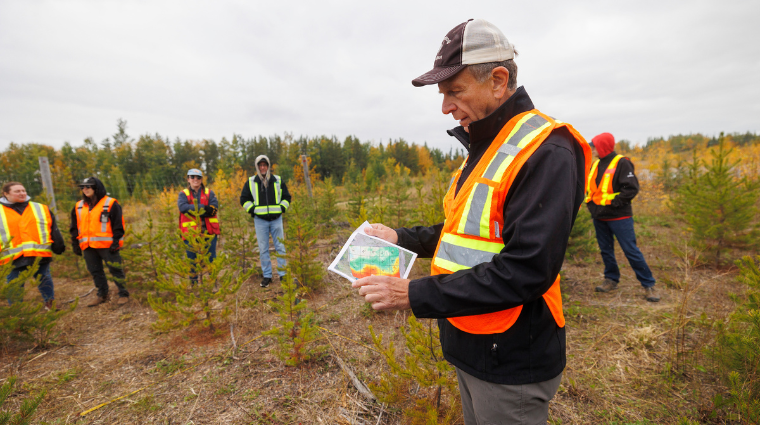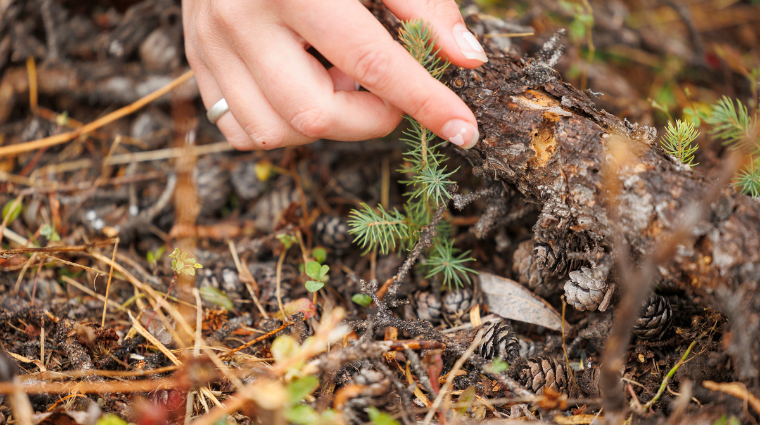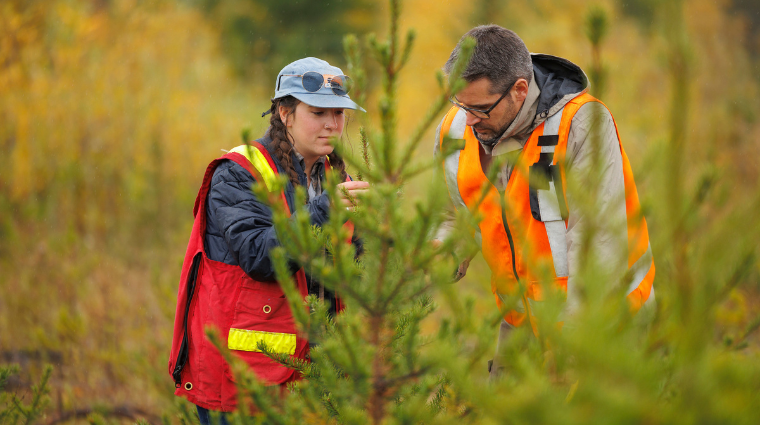
When Saskatchewan Polytechnic’s Sustainability-Led Integrated Centres of Excellence (SLICE) research chair David Halstead began a six-month applied research project with Alberta partner Reclaimit, Ltd. in 2019, he had no idea that he would be touring forestry industry executives through his research plot at Candle Lake more than four years later. The initial project, which started with a small research grant to investigate the application of various soil treatments on oilsands reclamation has yielded years of fruitful applied research, first with Reclaimit and biochar producer Airterra Canada and more recently with MEG Energy Corp., a large oil sands company in northern Alberta.
Results of the Candle Lake field trial placed biochar ahead of the various other treatments for its ability to promote jack pine seedling growth. Biochar, a substance made from organic biomass that has been thermochemically converted to charcoal, contributes to improved soil health through various pathways including the ability to selectively make up for nutrient and microbial deficiencies. Halstead’s foray into biochar began with the soil remediation project and has progressed to further research potentially using in-woods biochar for carbon sequestration.
His most recent partnership with MEG Energy grew from the initial Candle Lake jack pine inoculation trials. “It’s been exciting to see a small project grow and evolve,” says Halstead, who, through SLICE, is affiliated with the School of Agriculture, Natural Resources and Sustainability. We were initially able to extend our first Natural Sciences and Engineering Research Council of Canada (NSERC) grant to three years with Industrial Research Assistance Program (IRAP) funding from the National Research Council, which allowed us to do a thorough field study at our test plot. From that initial project, we secured a larger NSERC Applied Research and Development (ARD) grant to work with MEG Energy on their Alberta oilsands lease.”
MEG has been a certified gold member of the Wildlife Habitat Council (WHC) since 2016, which recognizes meaningful wildlife habitat management and conservation that goes beyond basic regulatory requirements. Their current research with Sask Polytech is examining biochar’s role in revitalizing stockpiled soils. This coming year Halstead’s team will be entering its third year of biochar-related research at MEG’s Christina Lake oilsands operation.
SLICE’s biochar expertise continues to grow and this excites Halstead and his team. In the past week, he and his colleagues in the natural resources applied research group put on a biochar workshop aimed at the Saskatchewan forestry industry. Local experts and speakers from as far as the United States joined Halstead to share their knowledge with industry leaders, who gathered for a full day of learning at Sask Polytech’s Prince Albert campus. The workshop was followed by an in-person tour the following day at the original Candle Lake research plot.
“For anyone who still needs convincing, the visual evidence after five complete growing seasons at our Candle Lake site is undeniable,” says Halstead. “Graphs are just graphs. The real magic following the presentations was showing the research plot where we grew the jack pine from 2019 to 2023. Participants were astounded by what they saw. There are so many intangibles when trying to create a forest, which is much more than just trees. Our workshop participants were surprised by the incredible diversity taking hold on the sandy, hostile ground, especially where biochar had been applied in the experiment involving various soil amendments and surface treatments.”
Darren McAvoy from Utah State University Extension and a presenter at the workshop noted that the duration of the Candle Lake research plot is unusual. “I have never seen a forestry research trial involving biochar conducted over this length of time,” he notes. “A long-term research plot is a valuable asset to this field of research. That plot wouldn't still be standing if it wasn't for the commitment displayed by David and his research team.” Other presenters, besides Sask Polytech, included Deb Dumroese, a United States Forest Service ecologist specializing in forest soils from Moscow, Idaho and Andrew Carpenter, from Reclaimit Ltd. out of Red Deer, Alberta.
Halstead and his research associates Leila Benmerrouche and Volker Schmid regularly employ students in their applied research efforts and Halstead loses count—he thinks nearly 20—as he tallies the number who have contributed to the biochar-related projects. In a recent update to colleagues and students he congratulates all of them for their dedication, hard work and contributions to the research, which he says have been immense. “Whether your involvement was in the lab, at Christina Lake, or Candle Lake, you’ve all made a significant contribution to global environmental stewardship through your research efforts,” he writes.
Dr. Robin Smith, the director of SLICE, cites forestry research as a growth area for Sask Polytech, and applauds Halstead and his team for their long-term commitment to studying biochar. “Sustainable forestry practices with a focus on the circular economy are on the rise,” says Smith, “and Sask Polytech’s biochar expertise positions us to assist local industry in working towards a more sustainable and profitable future.”
Read previous stories on this project:
- 2021: Innovative, ecological reclamation work empowering a better Saskatchewan through sustainability
- 2022: Addressing complex sustainability issues head on with SLICE
- 2022: Sustainability research at Saskatchewan Polytechnic recognized through RCE Awards



For more information about Sask Polytech applied research, including SLICE, visit saskpolytech.ca/research.
Saskatchewan Polytechnic is signatory to the SDG Accord. Sustainable Development Goal alignment is one of the ways Sask Polytech is leading the rise of polytechnic education.


